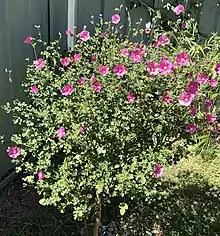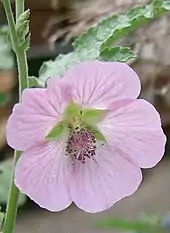Anisodontea capensis
Anisodontea capensis, known as African mallow, dwarf hibiscus, Cape mallow and false mallow, is a species in the tribe Malveae in the family Malvaceae that is native to the Cape Provinces of South Africa.[3][2] It has gained the Royal Horticultural Society's Award of Garden Merit as an ornamental.[4]
| Anisodontea capensis | |
|---|---|
 | |
| Scientific classification | |
| Kingdom: | Plantae |
| Clade: | Tracheophytes |
| Clade: | Angiosperms |
| Clade: | Eudicots |
| Clade: | Rosids |
| Order: | Malvales |
| Family: | Malvaceae |
| Genus: | Anisodontea |
| Species: | A. capensis |
| Binomial name | |
| Anisodontea capensis | |
| Synonyms[2] | |
|
List
| |
Description

It is an upright, dense subshrub that grows 1m to 1.5m tall and 90cm wide, and is found at altitudes of 670 to 2167 meters. It features green, hairy branches 2mm in length that age to brownish grey. Leaves are simple and ovate, palmately veined and three-lobed, 1mm in length. It has a woody base, so it is not a true herbaceous plant. During a cold spell, it may lose some of its leaves.[5]
From late winter or early spring to the first frost, it would display fuchsia, mauve or pink flowers with red centres that are borne in clusters with 5 petals, 1mm in diameter, resembling a hibiscus.[6]
Cultivation
The plant does well in Mediterranean style gardens, in containers and as a hedge. They thrive in well-drained soils with organic matter and must be watered regularly during hot and dry spells. Some light pruning is encouraged to promote bushy and compact growth.
It can be propagated from tip cuttings done in the summer, and as well by seed (which should be sown on the surface). It can bloom all year long provided it is protected from frost.[7]
References
- D.M. Bates Gentes Herbarum 10(3): 311–314, f. 15 1969
- "Anisodontea capensis (L.) D.M.Bates". Plants of the World Online. Board of Trustees of the Royal Botanic Gardens, Kew. 2017. Retrieved 10 October 2020.
- Anisodontea capensis (African Mallow)
- "Anisodontea capensis Cape mallow". The Royal Horticultural Society. Retrieved 10 October 2020.
- S.R. Hill, A Monograph of the Genus Malvastrum (Appendix III), Rhodora 84: 372-409 (1982)
- The Anisodontea Pages: Anisondontea capensis 2004 Stewart Robert Hinsley
- Cape mallow, all about caring for Anisodontea Nature & Garden